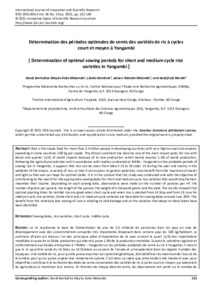| dc.contributor.author | Makanda, D.A.M. |
| dc.contributor.author | Bambele, L. |
| dc.contributor.author | Ndonda, A. |
| dc.contributor.author | Monde, G. |
| dc.date.accessioned | 2022-01-31T11:10:42Z |
| dc.date.available | 2022-01-31T11:10:42Z |
| dc.date.issued | 2021-09 |
| dc.identifier.citation | Makanda, D.A.M., Bambele, L., Ndonda, A. & Monde, G. (2021). Determination des periodes optimales de semis des varietes de riz a cycles court et moyen a Yangambi. International Journal of Innovation and Scientific Research, 56(2), 131-140. |
| dc.identifier.issn | 2351-8014 |
| dc.identifier.uri | https://hdl.handle.net/20.500.12478/7327 |
| dc.description.abstract | Rice is the staple food for more than 2.5 billion people in developing countries with very high annual consumption exceeding in some countries 100 kg per capita. The African continent has become one of the main import poles for rice with about one quarter (1/4) of world imports because of its low production, which barely reaches 1.5% of world production. Following the agricultural calendar and in accordance with studies conducted at INERA - Yangambi on the probable periods of sowing rice in Yangambi, it appears that rice can be sown from March 15 to October 15 during the year and mainly in the wetlands of the tropics. A variety of rice, so that it can express its genetic potential, must benefit from the maximum of water and light so that one can hope for optimal yields. It is in this context that this study was conducted and with the objective of contributing to the search for the appropriate sowing dates for short and medium cycle rice varieties that would help farmers maximize their income. Depending on each sowing date, observations were made on the number of panicles per m², the number of grains per panicle, the length of the panicle, the weight of a thousand grains and the yield. The results showed that optimal planting times for rainfed rice are good when short-cycle and when rice is planted from 16 May and from 15 June for medium-cycle rice varieties. Some short and / or medium cycle varieties are favorable for sowing dates around June 29th. The benefit from this relatively late sowing of June is alluding to bird damage and so the varieties that adapt to these dates have been identified. Le riz représente la base de l'alimentation de plus de 2,5 milliards de personnes dans les pays en voie de développement avec des consommations annuelles très importantes dépassant dans certains pays les 100 kg/habitant. Le continent africain est devenu l'un des principaux pôles d'importation de riz avec environ le quart (1/4) des importations mondiales à cause de sa faible production qui atteint à peine 1,5% de la production mondiale. Suivant le calendrier agricole et conformément aux études entreprises à l’INERA – Yangambi sur les périodes probables de semis du riz à Yangambi, il ressort que le riz peut être semé du 15 Mars au 15 Octobre au courant de l’année et principalement dans les régions humides des tropiques. Une variété de riz, pour qu’elle puisse exprimer son potentiel génétique, doit bénéficier du maximum de l’eau et de la lumière pour qu’on puisse espérer des rendements optima. C’est dans ce cadre que cette étude a été menée et avec pour objectif de contribuer à la recherche des dates de semis convenables des variétés de riz, à cycles court et moyen, qui aideraient les agriculteurs à maximiser leur revenu. En fonction de chaque date de semis, les observations ont porté sur le nombre de panicules par m², le nombre de grains par panicule, la longueur de la panicule, le poids de mille grains et le rendement. Les résultats obtenus ont montré que les périodes optimales de semis du riz pluvial sont bonnes lorsque le riz à cycle court est semé à partir du 16 mai et à partir du 15 juin pour les variétés de riz à cycle moyen. Certaines variétés à cycle court et/ou moyen sont favorables aux dates de semis oscillant autour du 29 juin. L’avantage qui découle de ce semis relativement tardif du mois de juin fait allusion aux dégâts des oiseaux et ainsi, les variétés qui s’adaptent à ces dates ont été identifiées. |
| dc.format.extent | 131-140 |
| dc.language.iso | fr |
| dc.subject | Sowing Date |
| dc.subject | Rice |
| dc.subject | Varieties |
| dc.subject | Income Generation |
| dc.subject | Central Africa |
| dc.title | Determination des periodes optimales de semis des varietes de riz a cycles court et moyen a Yangambi |
| dc.title.alternative | Determination of optimal sowing periods for short and medium cycle rice varieties in Yangambi |
| dc.type | Journal Article |
| cg.contributor.affiliation | Institut National pour l’Etude et le Recherche Agronomiques, RD Congo |
| cg.contributor.affiliation | International Institute of Tropical Agriculture |
| cg.contributor.affiliation | Institut Facultaire des Sciences Agronomiques, Democratic Republic of Congo |
| cg.coverage.region | Africa |
| cg.coverage.region | Central Africa |
| cg.coverage.country | Democratic Republic of the Congo |
| cg.coverage.hub | Central Africa Hub |
| cg.researchtheme | Biotech and Plant Breeding |
| cg.identifier.url | http://www.ijisr.issr-journals.org/abstract.php?article=IJISR-21-156-02 |
| cg.identifier.bibtexciteid | MAKANDA:2021 |
| cg.authorship.types | CGIAR and developing country institute |
| cg.iitasubject | Agronomy |
| cg.iitasubject | Food Security |
| cg.iitasubject | Plant Breeding |
| cg.iitasubject | Plant Production |
| cg.iitasubject | Socioeconomy |
| cg.journal | International Journal of Innovation and Scientific Research |
| cg.notes | Open Access Article; Open Access Article |
| cg.accessibilitystatus | Open Access |
| cg.reviewstatus | Peer Review |
| cg.usagerightslicense | Creative Commons Attribution 4.0 (CC BY 0.0) |
| cg.targetaudience | Scientists |
| cg.futureupdate.required | No |
| cg.identifier.issue | 2 |
| cg.identifier.volume | 56 |

